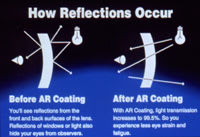DISPENSING AR
Who's the cream of the AR crop? To find out, we asked several labs to tell us who's doing a great job in communicating the benefits of AR to patients. The tips that follow are offered by just some of those dispensers who, according to their labs, are making AR a given, not just another add-on.
You were recommended by your lab as a business that is moving away from using AR as an add-on and moving toward making it more of a "given" on most or all pairs sold. How are you accomplishing this?
Two of the participants emphasize the importance of stressing the AR message in the exam room, and of passing that message through the doctor to the optician. Robert D. Patman, Director of Business Development at Texas State Optical (Dr. Michael Reade) in Houston, Texas, says, "Our doctors make a concentrated effort to introduce each patient to the optician. During this interaction several things must take place: The transfer of the patient's confidence in the doctor to the optician; a brief discussion of topics, lifestyle, and past difficulties with the patient's eyewear; and the doctor's recommendations on lenses and/or lens treatments. This should take no more than one to two minutes. It is a hard habit to build but one that reaps great rewards for the doctor, optician, and patient."
In Lake Oswego, Ore., Dan Robison, O.D. of Cascadia Vision Clinic, takes an even more hands-on approach. "I personally explain in the exam room the benefits of using a really good coating. I personally wear AR."
Several dispensers agree that AR is worth presenting to nearly everyone. Lorraine Manley, Eastern Medical Eye Center in Birmingham, Ala., says, "We really try to encourage people to get it, especially for higher prescriptions, and most people these days have computers and get glare from that. We have a lot of older patients in our practice, and glare is their number one complaint."
Dispensing Tips�How To Build Business With AR
This OLA-sponsored article looks at how several savvy dispensers have increased profits and patient satisfaction with AR
By Alex Yoho, ABOM


Using images such as these-showing the view of oncoming headlights through AR-coated and uncoated lenses-can help explain AR's benefits. Photos courtesy of AR Council.
What percent of jobs do you dispense with AR?
The range for dispensers we interviewed is from 45 to a whopping 90 percent. "We'd like to have 100 percent," says Manley, "but we are probably at 60 to 70 percent. Being an ophthalmology practice, we see a lot of high prescriptions that really benefit from AR."
What's the philosophy of your business regarding AR?
All view AR as a real benefit to patients. That is the bottom line, says Glynda Barker, ABOC of Plains Optical in Lubbock, Texas. "We stay on top of what is new and what is the very best on the market. We actually use two different AR coatings, so anybody who walks in is going to get the very best that's available."
For Viki McConnell of Dr. Ryan and Associates in Bend, Ore., the equation is simple: "We just want our patients to see their best, and we all wear AR."
Getting the doctor involved is also part of a winning philosophy, stresses Robison: "At the end of the exam when I'm making my recommendations, I'll explain, 'I would really recommend that you get an anti-reflective coating on your lenses,' and then I'll usually point to mine and say, 'Notice as you look at my glasses that you just don't see the lenses so they look much nicer; but more importantly, as I'm looking through them it really helps knock out the glare, particularly at night from headlights on cars.' And, usually they say, 'I want that.'"
|
|
|
Images and explanations of the technology can help in the dispensing process. All images courtesy of the AR Council.
What techniques can dispensers use to make AR a given?
Here are several good suggestions.
Dos and Don'ts. Patman offers a great list of Dos and Don'ts: Always use the word "treatments" instead of "coatings," he says, because consumers associate coatings with plated jewelry, peeling, and turning skin green. He also doesn't recommend using the abbreviation "AR" for anti-reflective, because consumers don't understand, and it lessens the optician's professionalism. Talk about the positives of "glare-free" lenses, enhanced vision, and improved cosmetics.
Positive Spin. If the patient is apprehensive, the proper terms can turn the drawbacks into positives. Patman's favorite: "These lenses are so clear that you will be able to see when your lenses are dirty. This way you know when to clean them. Clean lenses results in better vision."
Discussing warranties may also help allay fears-many anti-reflective treatments are warranted for two years.
Lifestyle Questions. Patman also believes showing is the best way to sell. He recommends lifestyle selling-whether through introductory questionnaire or by open-ended questions-to find the patient's needs, and then to exceed them.
A Script. Manley recommends keeping it simple: "All we do is ask the questions 'Do you have glare problems at any point, or with computer use?' and then we give them the benefits. Unless it's a money factor, most patients will do it. Especially if you tell them about the loss of their vision and what they'll gain back. We base it on information from a script that we got some time back that tells the percentages of reflection and benefits in different scenarios."
Brochures and Cards. Barker puts information in their hands. "Brochures are nice to hand to the patient, even if they've already purchased the coating. And when people come in just price shopping, our business cards have our title and business name on the front, and then on the back we have a blank price list for lenses and frames. We always include AR coating on them. We also give them a second card with an offer for a discount on a frame."
Simple Demo. Lesa Albert, licensed optician for Dr. Sid Savitt in Wickliffe, Ohio, shares a nifty low-tech approach, "One easy way to demonstrate the appearance of AR is to pop one of the demo lenses out of the frame they are looking at and try it on yourself. This gives them a good idea of what an AR coat can do."
Soft Sell. McConnell goes high tech and soft sell: "We always just demonstrate AR to a patient by using the frame that they are interested in. I'll take my glasses off and put theirs on. Right away they see the glare from the demo lenses. Then we'll use our Smart Mirror, which can simulate their frame with and without reflections. Usually I just let them know it's available to them, then demonstrate it and say, 'I just wanted to make sure you were informed about the options available to you.' This allows me to avoid a hard sale, which I'm uncomfortable with. And when they're informed, they just naturally take it."

According to Manley, their lab has helped with specials and packages that can be passed along to patients, making AR more enticing. Barker's lab helps with information for newspaper ads and the newsletter. And to McConnell, the facts that they stand behind the warranty, provide demo lenses, and help educate the staff are most important. Robison agrees, adding, "Our rep will come in and spend hours teaching a new staff member. They also keep us abreast of new products."
What does the future hold for AR?
Manley suggests that AR may become "as common as scratch coatings," and that then patients won't have to wait so long for their eyewear.
For Barker, one answer is profitability. "We set goals like selling one more AR coating each day, and it's astounding the amount of money you can make. Just take our least expensive AR coating at $65 times five days per week times 52 weeks. That brings in $16,900 in a year just from selling one more per day! My co-manager Ann and I sit down once a week to compare last year's figures and set goals that involve the doctor and dispensers. These strategies," concludes Barker, "should make our future for AR sales very bright."




